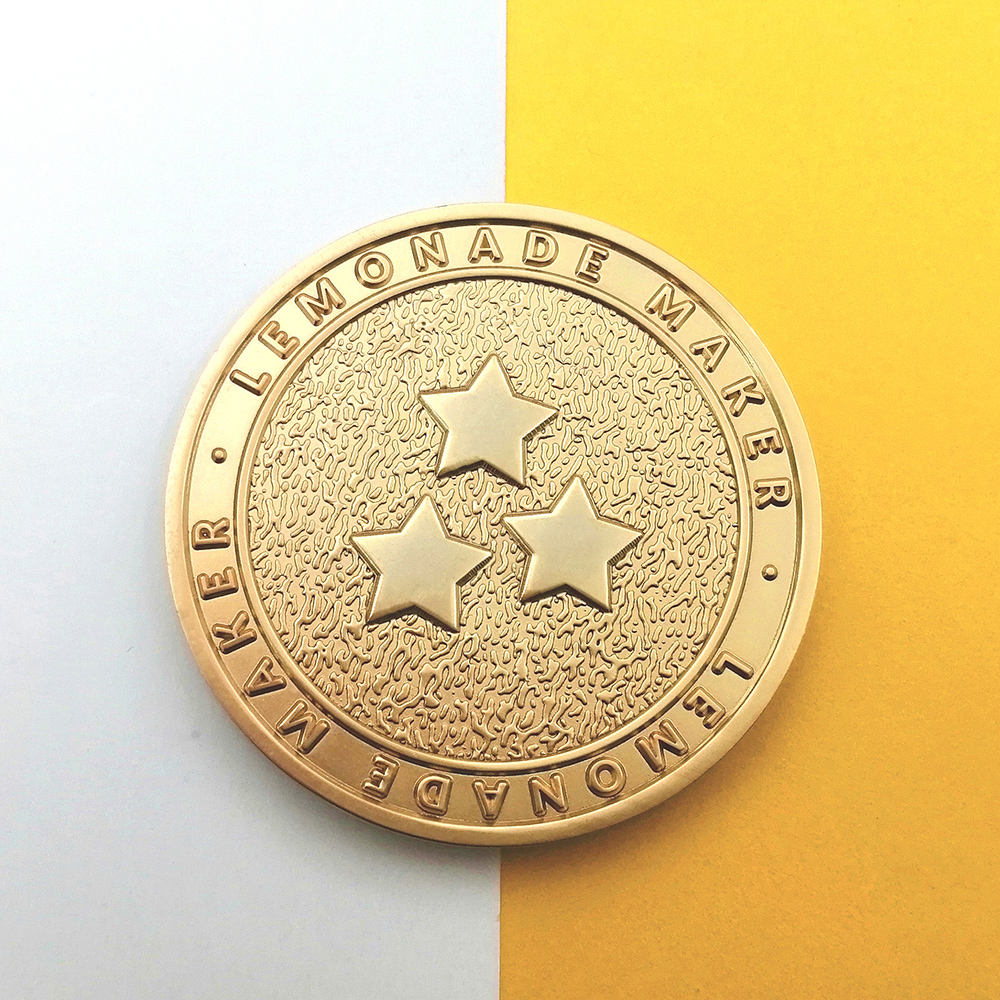| Availability: | |
|---|---|
| Quantity: | |

| Product | Souvenir Coins/ Challenge coins/ Commemorative Coins/ Proof Coins |
| Size | 1.5", 1.75", 2", 2.25", 2.5", 3". also as your request |
| Thickness | 2mm,2.5mm,3mm,3.5mm,4mm,5mm,6mm |
| Material | Brass, Copper, Zinc alloy, Iron, Aluminum, etc. |
| Process | Die Struck /Die Casting |
| Plating | Shiny Finished: Gold/Silver/Nickel/Copper/Brass Antique Finished: Antique Gold/Antique Silver/Antique Copper/Antique Brass |
| Painting | Soft Enamel/Imitation Hard Enamel/Poly Enamel |
| Epoxy | With/Without, as customer request |
| Packing | Poly bag, PVC pouch, opp bag, plastic box, velvet pouch, etc |
| MOQ | NO MOQ |
| Sample Time | 2D Design - 7days after artwork confirmed 3D design – 10 days after artwork confirmed |
| Lead Time | 12-20 days after sample confirmed |
| Delivery time | 12-20 days for MOQ (after samples be approved) |
| Shipping | By Air express: DHL, FedEx, UPS, etc. By Sea: from ShenZhen or HongKong port |
| Payment Method | T/T, Western Union, Alipay and Paypal |

























| Product | Souvenir Coins/ Challenge coins/ Commemorative Coins/ Proof Coins |
| Size | 1.5", 1.75", 2", 2.25", 2.5", 3". also as your request |
| Thickness | 2mm,2.5mm,3mm,3.5mm,4mm,5mm,6mm |
| Material | Brass, Copper, Zinc alloy, Iron, Aluminum, etc. |
| Process | Die Struck /Die Casting |
| Plating | Shiny Finished: Gold/Silver/Nickel/Copper/Brass Antique Finished: Antique Gold/Antique Silver/Antique Copper/Antique Brass |
| Painting | Soft Enamel/Imitation Hard Enamel/Poly Enamel |
| Epoxy | With/Without, as customer request |
| Packing | Poly bag, PVC pouch, opp bag, plastic box, velvet pouch, etc |
| MOQ | NO MOQ |
| Sample Time | 2D Design - 7days after artwork confirmed 3D design – 10 days after artwork confirmed |
| Lead Time | 12-20 days after sample confirmed |
| Delivery time | 12-20 days for MOQ (after samples be approved) |
| Shipping | By Air express: DHL, FedEx, UPS, etc. By Sea: from ShenZhen or HongKong port |
| Payment Method | T/T, Western Union, Alipay and Paypal |
























Coins have long served as symbols of significance, representing important events, achievements, and even belonging to exclusive groups. In recent years, two types of coins have gained prominence: commemorative coins and challenge coins. While they share similarities, they each possess unique characteristics and purposes. In this article, we will explore the fascinating world of commemorative coins and challenge coins, shedding light on their origins, designs, and significance.
Commemorative Coins: Celebrating Milestones
Commemorative coins are specially minted to honor historical events, milestones, or notable personalities. These coins hold a place of pride in the numismatic world and are often sought after by collectors. They serve as tangible reminders of significant moments in history and are frequently issued by governments, institutions, or organizations.
The designs of commemorative coins are carefully crafted to capture the essence of the event or individual being commemorated. They may feature intricate engravings, color enhancements, or even incorporate precious metals such as gold or silver. These coins are typically produced in limited quantities, further enhancing their value and desirability.
Commemorative coins can cover a wide range of themes, including anniversaries, sporting events, cultural celebrations, or historical figures. Their purpose extends beyond simple currency, as they act as keepsakes, mementos, and educational tools. Collectors often find joy in discovering the stories behind each coin, connecting them to significant moments in time.
Challenge Coins: A Tradition of Unity and Identity
Unlike commemorative coins, challenge coins have their roots in military tradition. These small, metal tokens bear the emblem or insignia of a specific military unit, organization, or event. Challenge coins are traditionally used to prove membership, create camaraderie, and foster a sense of belonging among military personnel.
The practice of challenge coins dates back to World War I, where soldiers carried them as symbols of affiliation and loyalty. The challenge aspect arises when a member of a particular unit presents their coin, and others must produce theirs to avoid penalties. These coins often hold great sentimental value and are cherished by those who receive them.
Over time, challenge coins have transcended their military origins and are now used in various settings, including law enforcement agencies, corporate entities, and social clubs. They serve as tokens of recognition, appreciation, and motivation. The designs of challenge coins are highly customizable, reflecting the unique identity and values of the group they represent.
Conclusion
Commemorative coins and challenge coins may share a common origin in their metallic composition, but their purposes and significance diverge. Commemorative coins serve as reminders of historical events, achievements, and notable figures. They are designed to capture the essence of these moments, allowing collectors and enthusiasts to connect with history on a tangible level.
On the other hand, challenge coins serve as emblems of unity, loyalty, and identity. With their military roots, they foster a sense of camaraderie and belonging among members of specific groups. Challenge coins have expanded beyond military circles and are now utilized by various organizations to strengthen bonds and recognize achievements.
Both types of coins hold immense value, albeit in different ways. Commemorative coins evoke historical significance and provide educational opportunities, while challenge coins foster a sense of community and pride. Whether one is a collector or a member of an organization, these special tokens continue to captivate and inspire individuals around the world.
Coins have long served as symbols of significance, representing important events, achievements, and even belonging to exclusive groups. In recent years, two types of coins have gained prominence: commemorative coins and challenge coins. While they share similarities, they each possess unique characteristics and purposes. In this article, we will explore the fascinating world of commemorative coins and challenge coins, shedding light on their origins, designs, and significance.
Commemorative Coins: Celebrating Milestones
Commemorative coins are specially minted to honor historical events, milestones, or notable personalities. These coins hold a place of pride in the numismatic world and are often sought after by collectors. They serve as tangible reminders of significant moments in history and are frequently issued by governments, institutions, or organizations.
The designs of commemorative coins are carefully crafted to capture the essence of the event or individual being commemorated. They may feature intricate engravings, color enhancements, or even incorporate precious metals such as gold or silver. These coins are typically produced in limited quantities, further enhancing their value and desirability.
Commemorative coins can cover a wide range of themes, including anniversaries, sporting events, cultural celebrations, or historical figures. Their purpose extends beyond simple currency, as they act as keepsakes, mementos, and educational tools. Collectors often find joy in discovering the stories behind each coin, connecting them to significant moments in time.
Challenge Coins: A Tradition of Unity and Identity
Unlike commemorative coins, challenge coins have their roots in military tradition. These small, metal tokens bear the emblem or insignia of a specific military unit, organization, or event. Challenge coins are traditionally used to prove membership, create camaraderie, and foster a sense of belonging among military personnel.
The practice of challenge coins dates back to World War I, where soldiers carried them as symbols of affiliation and loyalty. The challenge aspect arises when a member of a particular unit presents their coin, and others must produce theirs to avoid penalties. These coins often hold great sentimental value and are cherished by those who receive them.
Over time, challenge coins have transcended their military origins and are now used in various settings, including law enforcement agencies, corporate entities, and social clubs. They serve as tokens of recognition, appreciation, and motivation. The designs of challenge coins are highly customizable, reflecting the unique identity and values of the group they represent.
Conclusion
Commemorative coins and challenge coins may share a common origin in their metallic composition, but their purposes and significance diverge. Commemorative coins serve as reminders of historical events, achievements, and notable figures. They are designed to capture the essence of these moments, allowing collectors and enthusiasts to connect with history on a tangible level.
On the other hand, challenge coins serve as emblems of unity, loyalty, and identity. With their military roots, they foster a sense of camaraderie and belonging among members of specific groups. Challenge coins have expanded beyond military circles and are now utilized by various organizations to strengthen bonds and recognize achievements.
Both types of coins hold immense value, albeit in different ways. Commemorative coins evoke historical significance and provide educational opportunities, while challenge coins foster a sense of community and pride. Whether one is a collector or a member of an organization, these special tokens continue to captivate and inspire individuals around the world.

